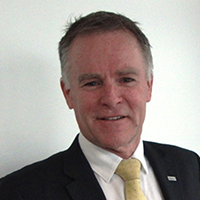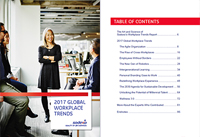Integrating the UN Sustainable Development Goals into today’s workplace
Interview with Neil Barrett, Group Vice President of Sustainable Development, Sodexo.
 Sodexo 2017 Global Workplace Trends Report is fresh off the presses with nine major trends that will impact our workplace today and in the years to come. Today we sat down with Neil Barrett, Group Senior Vice President Corporate Responsibility at Sodexo, to hear about how the SDGs will impact the workplace.
Sodexo 2017 Global Workplace Trends Report is fresh off the presses with nine major trends that will impact our workplace today and in the years to come. Today we sat down with Neil Barrett, Group Senior Vice President Corporate Responsibility at Sodexo, to hear about how the SDGs will impact the workplace.
You attended the UN Global Compact meeting where the Sustainable Development Goals (SDGs) were presented back in July – What is your take on the goals?
Neil Barrett: What really impresses me about the SDGs is the participation of a wide sector of governments, business, NGOs, trade unions, institutions and civil society – I think that’s a big difference from their predecessors, the Millennial Development Goals, which were shaped by governments rather than a broad number of organizations, institutions and civil society. Increasingly, we hear from our clients and through conversations with different parties, that the SDGs have already taken a prominent place in the way businesses are thinking about their responsibility actions and aligning their business objectives with the goals.
How do you think the SDGs will impact the workplace?
N.B.: These 17 goals will have an impact in the workplace because they drive change in the way society, communities and businesses interact on the topic of sustainable development and corporate responsibility.
From a Sodexo perspective, goal 5, diversity and inclusion, clearly aligns with what we’ve been doing for many years. It also outlines how organizations can better embrace this goal and what actions need to be put in place.
On a personal level, I have two 7-year-old granddaughters. My hope is that with these goals in place, when they enter the workforce, they won’t even understand how we started off the 21st century in terms of gender inequality. They will walk into an environment where gender imbalance is an issue belonging to the past. The goal in and of itself will one day seem ridiculous because it will be so engrained in their lives.
There has been this idea in the past that supporting sustainability may have an adverse effect on a company’s bottom line. But many companies today not only want to do it for themselves, but are being asked by clients. Thoughts?
N.B.: Increasingly people want to work for companies that are more responsible and are committed to improving their sustainable development performance, particularly millennials entering the workplace. Moreover, as employee awareness grows, we need to continue to support the awareness and behavior patterns by improving their knowledge and skills, recognizing that these skills can assist beyond the workplace. For example, saving energy, water or eliminating food waste are not only examples of operational excellence within the workplace, but they can contribute to good sustainable outcomes at home.
From a global perspective, have you seen a difference between countries or regions in terms of embracing the goals or putting regulations in place?
N.B.: I don’t like to generalize, but I think we can say that there are emerging countries where this challenge will be greater. What I find fascinating is that 193 countries have signed onto the SDGs – this is unheard of in terms of such a global commitment across such a broad range of issues. That really is another reason why I’m very hopeful that there’s going to be a lot of progress on these goals. Right now, there are different levels of sustainable development maturity and parts of the world that aren’t as advanced. Increasingly there are initiatives and projects that can help, encourage them, and provide knowledge and expertise they can adopt and act upon.
Are there certain industries that are adopting these goals faster than others?
N.B.: Today, many major multinational organizations are doing great things; they are driving change, responding to the SDGs and setting goals that are aligned. That said, one of the big challenges into the future is addressing globally, small to medium organizations that are less engaged. In short, although large companies and governments are working to make a difference, some of the indicators are not moving, or not moving quickly enough on a global scale. Somehow we’ve got to engage more extensively with small and medium businesses to bring them along on this journey.
How can that process begin? Can you provide any concrete examples?
N.B.: In the same way that the SDGs were formed in a collaborative way with governments, municipalities, NGOs, and business, I think we’re going to see through reporting, transparency and regulations, businesses adopting better practices. Looking at the issue of food waste for example, around the world there are now increasingly more and more municipalities or regions that are legislating and regulating against the dumping of organic material. This is a way to drive change. To revise the way we think about the value chain. How we can we implement the notion of the circular economy where waste is eliminated – one where resources are valued and that value is retained? Rather than the more linear system we have today where we produce, we consume and we throw away what’s left over at the end. This is not sustainable and it can’t be part of the future.
How do these SDGs fit into Sodexo’s future?
N.B.: Most large organizations have their own corporate responsibility roadmap that determines what is important to them as an organization and to the stakeholders that are part of their ecosystem. Ideally, companies will align these commitments or goals with the relevant SDGs. For example, some years back Sodexo made the decision to only serve sustainable fish and seafood in all of our restaurants, on a global basis. This was Sodexo saying, protecting the environment is important to us as a company. I think this is part of the way forward – making good choices, well explained, well exampled and well defined.
A company like Sodexo has a responsibility to tell the sustainability story of the food on the plate. A responsibility to raise awareness and encourage consumers to make healthy choices. Ultimately, it’s the consumer’s decision, but we have an increasing responsibility to inform, engage, and create awareness around the products we serve.


